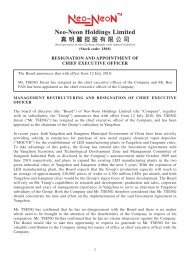Annual Report 2011 年 報 - Neo-Neon LED Lighting International Ltd
Annual Report 2011 年 報 - Neo-Neon LED Lighting International Ltd
Annual Report 2011 年 報 - Neo-Neon LED Lighting International Ltd
You also want an ePaper? Increase the reach of your titles
YUMPU automatically turns print PDFs into web optimized ePapers that Google loves.
NotES to tHE CoNSoLIDAtED<br />
fINANCIAL StAtEMENtS<br />
4. SIGNIFICANT ACCOUNTING POLICIES (Continued)<br />
Impairment of tangible and intangible assets other than goodwill (see the accounting policy<br />
in respect of goodwill above) (Continued)<br />
Where an impairment loss subsequently reverses, the carrying amount of the asset is increased to the revised<br />
estimate of its recoverable amount, but so that the increased carrying amount does not exceed the carrying<br />
amount that would have been determined had no impairment loss been recognised for the asset in prior<br />
years.<br />
A reversal of an impairment loss is recognised as income immediately.<br />
Taxation<br />
Income tax expense represents the sum of the tax currently payable and deferred tax.<br />
The tax currently payable is based on taxable profit for the period. Taxable profit differs from profit as<br />
reported in the profit or loss because it excludes items of income or expense that are taxable or deductible<br />
in other periods and it further excludes items that are never taxable or deductible. The Group’s liability for<br />
current tax is calculated using tax rates that have been enacted or substantively enacted by the end of the<br />
reporting period.<br />
Deferred tax is recognised on temporary differences between the carrying amounts of assets and liabilities in<br />
the financial statements and the corresponding tax base used in the computation of taxable profit. Deferred<br />
tax liabilities are generally recognised for all taxable temporary differences. Deferred tax assets are generally<br />
recognised for all deductible temporary difference to the extent that it is probable that taxable profits will be<br />
available against which those deductible temporary differences can be utilised. Such assets and liabilities are<br />
not recognised if the temporary difference arises from goodwill or from the initial recognition (other than in a<br />
business combination) of other assets and liabilities in a transaction that affects neither the taxable profit nor<br />
the accounting profit.<br />
Deferred tax liabilities are recognised for taxable temporary differences associated with investments in<br />
subsidiaries and associates, and interests in joint ventures, except where the Group is able to control the<br />
reversal of the temporary difference and it is probable that the temporary difference will not reverse in the<br />
foreseeable future. Deferred tax assets arising from deductible temporary differences associated with such<br />
investments and interests are only recognised to the extent that it is probable that there will be sufficient<br />
taxable profits against which to utilise the benefits of the temporary differences and they are expected to<br />
reverse in the foreseeable future.<br />
The carrying amount of deferred tax assets is reviewed at the end of the reporting period and reduced to<br />
the extent that it is no longer probable that sufficient taxable profits will be available to allow all or part of the<br />
asset to be recovered.<br />
Deferred tax assets and liabilities are measured at the tax rates that are expected to apply in the period in<br />
which the liability is settled or the asset is realised, based on tax rate (and tax laws) that have been enacted<br />
or substantively enacted by the end of the reporting period. The measurement of deferred tax liabilities and<br />
assets reflects the tax consequences that would follow from the manner in which the Group expects, at the<br />
end of the reporting period, to recover or settle the carrying amount of its assets and liabilities. Deferred tax<br />
is recognised in profit or loss, except when it relates to items that are recognised in other comprehensive<br />
income or directly in equity, in which case the deferred tax is also recognised in other comprehensive income<br />
or directly in equity respectively.<br />
ANNUAL REPORT <strong>2011</strong> 63




